
The unification of Italy, also known as the Risorgimento, was the 19th century political and social movement that in 1861 ended in the annexation of various states of the Italian peninsula and its outlying isles to the Kingdom of Sardinia, resulting in the creation of the Kingdom of Italy. Inspired by the rebellions in the 1820s and 1830s against the outcome of the Congress of Vienna, the unification process was precipitated by the Revolutions of 1848, and reached completion in 1870 after the capture of Rome and its designation as the capital of the Kingdom of Italy.

The siege of Charleston was a major engagement and major British victory in the American Revolutionary War, fought in the environs of Charles Town, the capital of South Carolina, between March 29 and May 12, 1780. The British, following the collapse of their northern strategy in late 1777 and their withdrawal from Philadelphia in 1778, shifted their focus to the North American Southern Colonies. After approximately six weeks of siege, Major General Benjamin Lincoln, commanding the Charleston garrison, surrendered his forces to the British. It was one of the worst American defeats of the war.
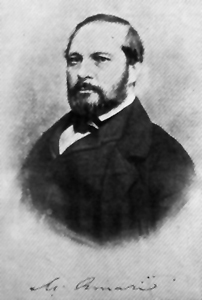
Michele Benedetto Gaetano Amari was a Sicilian patriot, liberal revolutionary and politician of aristocratic background, historian and orientalist. He rose to prominence as a champion of Sicilian independence from the Neapolitan Bourbon rule when he published his history of the War of the Sicilian Vespers in 1842. He was a minister in the Sicilian revolutionary government of 1848–9 and in Garibaldi's revolutionary cabinet in Sicily in 1860. Having embraced the cause of Italian unification, he helped prepare the annexation of Sicily by the Kingdom of Sardinia and was active in his later years as a senator of the Kingdom of Italy.

The Expedition of the Thousand was an event of the unification of Italy that took place in 1860. A corps of volunteers led by Giuseppe Garibaldi sailed from Quarto al Mare near Genoa and landed in Marsala, Sicily, in order to conquer the Kingdom of the Two Sicilies, ruled by the Spanish House of Bourbon-Two Sicilies. The name of the expedition derives from the initial number of participants, which was around 1,000 people.

The Sicilian revolution of independence of 1848 which commenced on 12 January 1848 was the first of the numerous Revolutions of 1848 which swept across Europe. It was a popular rebellion against the rule of Ferdinand II of the House of Bourbon, King of the Two Sicilies. Three revolutions against the Bourbon ruled Kingdom of the Two Sicilies had previously occurred on the island of Sicily starting from 1800: this final one resulted in an independent state which survived for 16 months. The Sicilian Constitution of 1848 which survived the 16 months was advanced for its time in liberal democratic terms, as was the proposal of a unified Italian confederation of states. It was in effect a curtain-raiser to the end of the Bourbon kingdom of the Two Sicilies, finally completed by Giuseppe Garibaldi's Expedition of the Thousand in 1860, the Siege of Gaeta of 1860–1861 and the proclamation of the unified Kingdom of Italy.
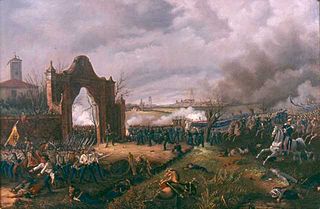
The First Italian War of Independence, part of the Italian Unification (Risorgimento), was fought by the Kingdom of Sardinia (Piedmont) and Italian volunteers against the Austrian Empire and other conservative states from 23 March 1848 to 22 August 1849 in the Italian Peninsula.
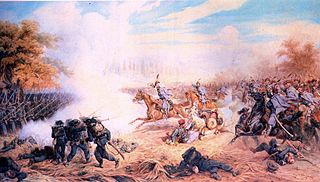
The Third Italian War of Independence was a war between the Kingdom of Italy and the Austrian Empire fought between June and August 1866. The conflict paralleled the Austro-Prussian War and resulted in Austria conceding the region of Venetia to France, which was later annexed by Italy after a plebiscite. Italy's acquisition of this wealthy and populous territory represented a major step in the Unification of Italy.
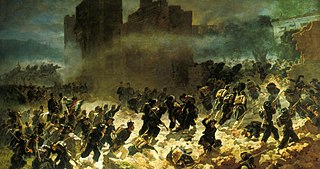
The Capture of Rome occurred on 20 September 1870, as forces of the Kingdom of Italy took control of the city and of the Papal States. After a plebiscite held on 2 October 1870, Rome was officially made capital of Italy on 3 February 1871, completing the unification of Italy (Risorgimento).
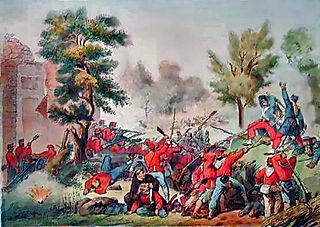
The Battle of the Volturno refers to a series of military clashes between Giuseppe Garibaldi's volunteers and the troops of the Kingdom of Two Sicilies occurring around the River Volturno, between the cities of Capua and Caserta in northern Campania, in September and October 1860. The main battle took place on 1 October 1860 between 30,000 Garibaldines and 25,000 Bourbon troops (Neapolitans).
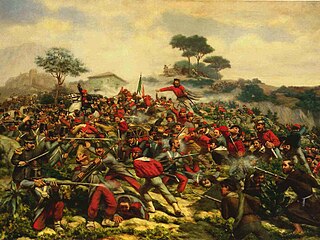
The Battle of Calatafimi was fought on the 15 May 1860 between Giuseppe Garibaldi's Redshirts and the troops of the Kingdom of the Two Sicilies at Calatafimi, Sicily, as part of the Expedition of the Thousand. The battle was the first of Garibaldi's victory during his invasion of Sicily in 1860 and saw his 'Thousand' defeat a larger Neapolitan army sent from Palermo to block the roads to the Sicilian capital.

The Dictatorship of Garibaldi or Dictatorial Government of Sicily was the provisional executive that Giuseppe Garibaldi appointed to govern the territory of Sicily during the Expedition of the Thousand in 1860. It governed in opposition to the Bourbons of Naples. The word dictator did not, at this time, always imply a despotic ruler.

Giuseppe Natoli Gongora di Scaliti was an Italian lawyer and politician from the Mediterranean island of Sicily. He was Minister of Agriculture under Camillo Benso, Count of Cavour, in the first government of the Kingdom of Italy after unification in 1861.
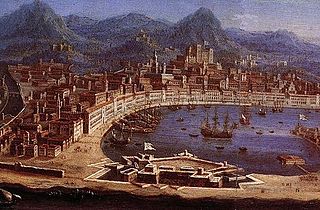
The Real Cittadella was a fort in Messina, Sicily. The Cittadella was built between 1680 and 1686 by the Spanish Empire, and it was considered to be one of the most important fortifications in the Mediterranean. Most of the fort was demolished in the 20th century, but some parts can still be seen.

The British Legion was a military corps composed of English and Scottish volunteers, who in 1860 joined Giuseppe Garibaldi during the Expedition of the Thousand and fought for the unification of Italy, together with the Italian Redshirts, as part of their Southern Army against the Bourbon Army of the Kingdom of the Two Sicilies.
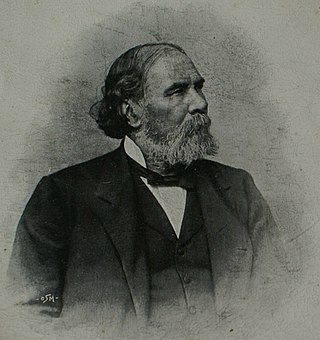
Domenico Menotti Garibaldi was an Italian soldier and politician who was the eldest son of Giuseppe Garibaldi and Anita Garibaldi. He fought in the Second and Third wars of Italian Unification, and organized the Garibaldi Legion, a unit of Italian volunteers who fought for Polish independence in the January Uprising of 1863. He also served in the Italian Chamber of Deputies.
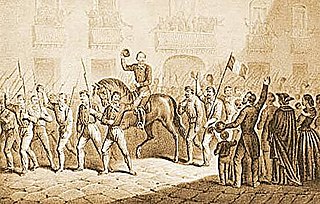
The Southern Army was the force of around 50,000 Italian and foreign volunteers which formed as a result of the Expedition of the Thousand. The name was coined by Giuseppe Garibaldi. Its officers wore red uniforms and so - like the Thousand - the force's rank and file became known as redshirts. It was dissolved before the proclamation of the Kingdom of Italy.

Francesco Landi was a Brigadier General from the Kingdom of the Two Sicilies. He was the main commander at the Battle of Calatafimi against Garibaldi's Redshirts during the Expedition of the Thousand.
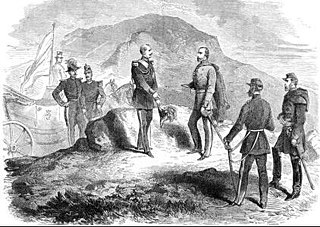
Ferdinando Lanza was a lieutenant-general who fought against Garibaldi's Expedition of the Thousand. During the conflict, Lanza was stationed at Palermo but surrendered after the siege on May 30, 1860.

Ferdinando Beneventano del Bosco was a Two Sicilian Brigadier General of the Army of the Two Sicilies. He was one of the few charismatic figures during the Expedition of the Thousand and a primary figure of Two Sicilian resistance against the Sardinian forces.

Giovanni Antonio Riso (Notarbartolo) (1836-1901), Baron of Colòbria, was a Sicilian patriot active in the Unification of Italy and scion of one of the wealthiest families in 19th-century Palermo Sicily.




























